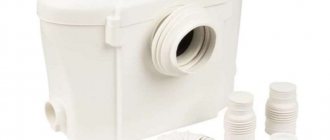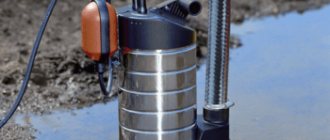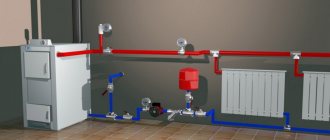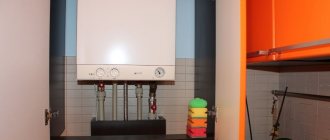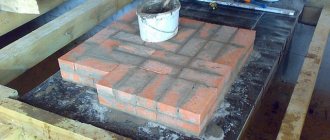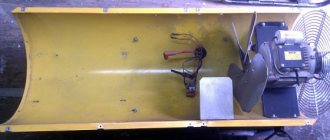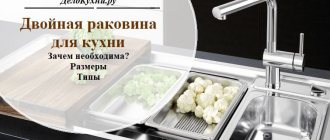If there is a drilled well on a dacha or home plot, then in order to organize irrigation of garden areas and to meet the needs of home water supply, you will need to use a special self-priming pump. Before purchasing it, you should learn more about the operating principles of such equipment, familiarize yourself with the advantages/disadvantages of the models on the market, and study the installation and connection procedures. This information will be useful not only to amateur gardeners, but also to residents of private houses who have problems with water delivery.
Structure and functionality of a surface pump
Self-priming pumps lift liquid from depth due to the pressure difference formed when it drops. The maximum effective depth of such a pump is about 10 meters, but usually domestic wells do not reach such depths, but are only 8-9 meters, so the power of the device is usually more than enough. The operating mechanism is based on blades rotating inside the device, which create areas of low pressure, which it quickly tries to fill with liquid.
Such units consist of an electric motor, a working chamber that pumps liquid through a pumping mechanism, which, in turn, is driven by a special rotor. All active elements are located around a shaft passing through a seal, and it also prevents liquid from getting into the electrical parts of the device.
There are two types of seals - end seals and seals. The first option is not often found due to its high cost and reliability, but the second option is provided by most existing models.
IMPORTANT! In “nature” there are models that are completely devoid of seals. They are replaced in the design by magnetic couplings. This solution often indicates greater reliability of the device, but it significantly reduces its performance. The reason for this is a decrease in torque during transmission from shaft to shaft. However, such equipment is considered the most expensive.
Based on the type of suction force generated, pumps are divided into vortex and centrifugal. Both designs use an impeller (impeller of water distillation equipment).
Centrifugal pumps
At first glance, the working chamber of such a pump looks like a snail shell. In its center there are blades that make up the water wheel. The wheel can be a single copy (single-stage pump), or there can be several of them (multistage form). Accordingly, the former will always work with the same power, and on the latter it (power) can be changed.
The blades are arranged in such a way that they diverge from the shaft and are bent in the direction opposite to rotation. As the wheel rotates, the blades push water away from themselves, pressing it against the chamber sides, thereby creating a centrifugal effect. The liquid seeps through the diffuser - the minimum distance from the tips of the blade to the wall. Thus, high pressure arises on the diffuser, due to which the liquid goes up, swirls according to the “snail” principle, and then is transferred towards the outlet pipe.
At the same moment, a reduced pressure arises in the central part of the chamber, which draws water along with it through the inlet pipe. From it the main line goes either into a well or into a reservoir. This process cannot even be called cyclic - it is simply endless, because it occurs permanently as long as the electric motor is running and the shaft is spinning.
In general, this method of pumping liquid is quite effective, however, it has a significant drawback - if the system is filled with air, then reduced pressure cannot be created. The device will run idle, which will inevitably lead to overheating and breakdown. In order to avoid such a situation, when the equipment is first started, water is poured into it in order to fill the working chamber and supply line. The water will no longer be able to flow back, because the check valve will prevent this. It is equipped with a coarse filter located at the end of the inlet line, which is immersed in the source.
Vortex pumps
They have a slightly different operating principle. The main difference is that the impeller has a different shape - the blades on it are located on both sides at once, they are radial and straight. This structure is called an impeller. The design of the working chamber is designed in such a way that the wheel is tightly surrounded, and only the side partitions have a large gap.
The rotation of this wheel makes the water move. Thanks to centrifugal force, the liquid is pressed against the chamber walls and moves along it. And when the second side of each blade touches, it receives another portion of acceleration, which is why it spins in the form of a vortex. All this action forms a vortex flow, which gave the name to this design.
By the way, this system creates pressure 5-7 times higher than that of centrifugal pumps of similar power. This system should be used in cases where it is necessary to provide high pressure with low water flow rates. Vortex pumps can create an area of low pressure even when partially filled with air, so cases of dry operation and overheating of such equipment are extremely rare. The mixture of water and air will not affect the performance or power of the device. Therefore, when starting up for the first time, the chamber can only be partially filled with water. The disadvantage of vortex models is the high energy consumption, so such equipment is used where water consumption is relatively small.
Ejector - a device for raising water from great depths
To solve problems of water intake from great depths, an ejector is used. It is a specially shaped tube that has one inlet and two outlets - the lower expanded inlet is used to draw fluid from the well, and the other, which narrows inside, is used to recirculate water received from the pump. Then, through the outlet, both flows are mixed and rush back to the unit.
All this works on the provisions of Bernoulli's law. Water passing through a narrow pipe creates a turbine effect, and, having received additional acceleration, it creates a low-pressure area in the ejector. These voids are instantly filled with liquid, which is supplied through the main nozzle. As a result, the pressure in the well itself increases significantly, its difference with the pressure on the unit wheel also increases, so the water begins to move quickly upward.
The disadvantage of the ejector is that it will reduce the efficiency of the equipment by 35-38% (water will have to be constantly returned to the well), but the lifting depth increases from 10 to 40 meters. Typically, an ejector is included with any pump.
Additional characteristics of pumping equipment
- The pump capacity, as a rule, is 3-5 cubic meters of water per hour, which is enough for a house with a decent number of residents;
- The pressure in the system is approximately 4 Bar - it is sufficient for all plumbing fixtures;
IMPORTANT! The performance of the pump will depend not only on the depth of the well, but also on the length of the water supply system and the number of water points.
- Pumping equipment is quite noisy in itself, so it should be installed away from residential premises.
Pumps for wells no more than 20 meters deep
For wells 10 or 15 meters deep, injection-type surface pumping equipment can be used, which is much more convenient to maintain than submersible devices. Meanwhile, it should be borne in mind that such equipment is characterized by low efficiency. Because of this, submersible equipment is most often purchased to pump out liquid media from wells of such depth.
In order to select pumping equipment with the appropriate characteristics for a well whose depth does not exceed 20 meters, you must perform the following steps:
- The value of the well depth (it can be measured with a simple rope with a weight at the end) must be added to the distance over which the liquid medium must be transported along the horizontal section of the pipeline.
- From the obtained value, subtract the distance by which the submersible pump will be removed from the bottom of the underground source.
- Based on the calculated distance, you can select pumping equipment with the required characteristics. It should be taken into account that to transport liquid over a distance of 10 meters, a pressure of 1 atmosphere is required.
- The power of the selected equipment, in order to take into account the hydraulic losses occurring in the pipeline, must be increased by 10%.
For example, let’s select a pump for a well 20 meters deep, which should create a pressure equal to 2 atmospheres (20 meters) in a pipeline 40 meters long. If the distance at which the pump is located from the bottom of the well is 4 meters, the pressure that the selected equipment should create can be calculated as follows:
20+20–4+(40x0.1) = 40 m
Based on the obtained value, you can select inexpensive pump models made in China or Russia, or more expensive equipment from European manufacturers.
Main differences between vortex and centrifugal pumps
Centrifugal models are much larger than vortex models in size and weight; however, they are somewhat quieter. In addition, the simplicity of their design can safely allow the pumping of liquids with foreign inclusions - such as fecal and drainage units. Vortex pumps are quite sensitive, so they are specially equipped with filters;
Centrifugal units are considered more reliable - their service life can be up to 20 years. They are also quite simple to repair; if you wish, you can fix the problem yourself. Vortex units are considered more delicate equipment that carries out scrupulous cleaning and high-speed pumping of liquid - it is unlikely that you will be able to repair them yourself;
Energy consumption of vortex pumps is 40% more.
Rules for choosing wisely
Before purchasing, you should read the information contained in the product data sheet. You need to be interested in the following information:
- Power and productivity - this indicator must be compared with the distance of the well from the house, the number of water distribution points and the maximum volume of water required at any given moment. Naturally, this will require precise mathematical calculations. However, by correctly calculating the required pump power, you can extend its service life, as well as avoid premature breakdowns and overheating;
- The minimum output pressure should be 0.3 Bar. Otherwise, household appliances connected to plumbing communications may fail.
- It is also necessary to correlate the capabilities of the pump with the diameter of the casing pipe installed in the well. It is better to contact the specialists who carried out the drilling with this question.
How to choose a pump for a well: recommendations for choosing pumping equipment
The operation of a well is impossible without the use of a mandatory component of its arrangement - a pump. After all, a bucket is absolutely not suitable for collecting water from a narrow trunk. In addition, lifting from the depths and transporting water manually would take too much effort and time. I don’t want to waste either one or the other, do you agree?
Properly selected pumping equipment will fill containers in a bathhouse, home, or garden in a matter of minutes. Now it is possible to purchase equipment to service an object of any size. On its basis, you can easily build an automatic water supply system that does not depend on centralized supplies and the participation of owners in the pumping process.
We will tell you in great detail how to choose a pump for a well, what the future owner of the device needs to take into account and provide. A scrupulous explanation of important points for the user is supplemented with photos and video guides.
Rating of the best self-priming pumps for 2022
The pump models presented below are ordered in ascending price order.
The best self-priming pumps costing up to 10,000 rubles
5th place: ZUBR NPG-M1-400
The device has an automatic on/off function and a thermal fuse to protect the electric motor. It is used for pumping clean and contaminated liquids, indispensable for drainage work, as well as for drainage and aeration.
Specifications:
| Name | Index |
| Lifting height, m | 6 |
| Capacity, l/min | 125 |
| Dry running protection | Eat |
| power, kWt | 0.4 |
| Suction depth, m | 7 |
| price, rub. | 1940 |
BISON NPG-M1-400
Advantages
- The body is made of reinforced plastic;
- Ease of transportation (presence of a special handle);
- Universal fitting.
Flaws
- Variations in performance.
4th place: AL-KO Drain 20000 HD
Designed for pumping out liquids with foreign inclusions. Able to work in extreme conditions. Also suitable for draining basements and swimming pools. The impeller is shaped like a funnel, which increases the efficiency of the device. The kit includes a universal nipple.
Specifications:
| Name | Index |
| Lifting height, m | 5 |
| Capacity, l/min | 720 |
| Dry running protection | Eat |
| power, kWt | 0.43 |
| Suction depth, m | 6 |
| price, rub. | 3590 |
AL-KO Drain 20000 HD
Advantages
- Special running wheel technology;
- Increased size of foreign grain – up to 30 mm;
- Durable housing.
Flaws
- Heavy weight.
3rd place: Metabo P 2000 G
The model belongs to the line of budget pumps and is intended exclusively for collecting clean water. It has some internal rubberized parts, which reduces operating noise during operation. Has excellent throughput. Afraid of low temperatures
Specifications:
| Name | Index |
| Maximum depth, m | 8 |
| power, kWt | 0.45 |
| Productivity, l/h | 2000 |
| Maximum height (with ejector), m | 30 |
| price, rub. | 4400 |
Metabo P 2000 Gi
Advantages
- Reasonable price;
- Increased pumping distance – 30 meters;
- High quality build.
Flaws
- Reduced power;
- Inability to work in low temperature conditions.
2nd place: Gilex Jumbo 70/50 P 3701
Model from a Russian manufacturer. It has an increased immersion depth of 9 m. The kit includes an ejector. The electric motor is characterized by extremely economical energy consumption. Due to the use of special treatment to which the chassis elements have been subjected, the service life has been significantly increased (the pump is designed for a minimum of 5 years of continuous operation).
Specifications:
| Name | Index |
| Lifting height, m | 5 |
| power, kWt | 1.1 |
| Dry running protection | Absent |
| Capacity, l/min | 70 |
| Suction depth, m | 9 |
| price, rub. | 6940 |
Gilex Jumbo 70/50 P 3701
Advantages
- Ease of use;
- Reasonable cost;
- High quality build.
Flaws
- High noise level.
1st place: GARDENA 8500 Comfort
All pump parts are made of high-strength materials that perfectly withstand both chemical and mechanical stress. Has a high level of fluid pumping speed. The power cable has been significantly increased - up to 10 meters. Maximum immersion depth is 8 m.
Specifications:
| Name | Index |
| Lifting height, m | 8 |
| Productivity, m3/hour | 8.3 |
| Dry running protection | There is |
| power, kWt | 0.38 |
| Suction depth, m | 7 |
| price, rub. | 9300 |
GARDENA 8500 Comfort
Advantages
- Reduced noise level;
- High-quality assembly;
- Advanced functionality.
Flaws
- High price among analogues.
The best self-priming pumps costing over 10,000 rubles
2nd place: Calpeda MXHM 205/A 230/50 Hz
A very popular model due to its high-quality and uninterrupted operation in low temperatures. It has very compact dimensions. The case is made according to the principle of a monolithic type and has special moisture/dustproof properties. Equipped with a fuse to prevent overheating in case of interruptions in the water supply.
Specifications:
| Name | Index |
| Suction depth, m | 8 |
| power, kWt | 0.75 |
| Productivity, l/h | 4800 |
| Weight, kg | 12.5 |
| Suction system | multi-stage |
| price, rub. | 24105 |
Calpeda MXHM 205/A 230/50 Hz
Advantages
- Long service life (monolithic body);
- Increased reliability;
- Availability of components (universal attachments).
Flaws
- For use with clean water only.
1st place: Grundfos JP 6 46811202
Designed exclusively for pumping liquids from wells, boreholes, and reservoirs. It has a filter with carbon brushes, which allows you to get water of almost drinking quality. Can be used as water supply equipment for small residential buildings, and as a small fire extinguishing installation.
Specifications:
| Name | Index |
| Lifting height, m | 6 |
| Productivity, m3/hour | 55 |
| Dry running protection | Not required |
| power, kWt | 1.4 |
| Suction depth, m | 5 |
| price, rub. | 34000 |
Grundfos JP 6 46811202
Advantages
- Increased power;
- Durable housing;
- Multifunctionality.
Flaws
- Extremely high price.
Analysis of small nuances
The quality of drilling work is another point that needs to be taken into account when choosing a pump for a well. If drilling is carried out using professional equipment and a specialized team, such a well is considered more reliable.
If the drilling was carried out by shabatniks or the owners of the site with the help of amateur friends, the quality of the well is unlikely to be ideal.
“Amateur” wells, as practice has shown, are more susceptible to the processes of filling and sanding. Therefore, for such wells it is recommended to use special pumps designed to operate in difficult conditions. Equipment of this type is more expensive.
But it better withstands situations where they receive water with a large amount of contaminants. Under the same loads, conventional pumps break down much more often. Owners of “professional” wells have more options when choosing equipment, since they can choose either a universal or a special pump.
It is not always convenient to use a rubber hose to lift water from the depth of a well to a height. During operation of the pumping equipment, the air inside the hose becomes rare, causing the walls of the hose to collapse and the flow of water stops. It is simple to prevent this phenomenon: instead of a rubber hose, you should use plastic structures of a suitable diameter.
An important indicator when choosing a pump is the approximate water consumption for one day. This is an average value, since water consumption usually increases in summer, and, on the contrary, decreases in winter. It is believed that the daily consumption rate for a family of three to four people is approximately 60-70 liters.
These figures do not take into account water consumption for irrigation and other household needs. The daily rate should be increased depending on the number of plants on the site, the presence of pets, etc.
Prudent owners most often choose four-inch casing pipes for a well, although structures with a diameter of three inches are also used in this capacity. The fact is that a significant part of the pumping equipment is designed specifically for a more spacious four-inch pipe.
To convert centimeters to inches, you should divide the measurement result with a tape measure by 2.54, since this is the number of centimeters that equals one inch.
Instead of an epilogue
When choosing a suction pump, you must always remember that it is complex technical equipment, so before purchasing you should clearly establish the purposes for which it is being purchased. Using a pump that is not suitable for a certain type of work will invariably lead to its failure. You should also pay attention to the warranty period: does it correspond to the type of equipment purchased? As a rule, it is larger for centrifugal ones, and smaller for vortex ones. It is better to buy a pump through online trading platforms, thus saving yourself from unnecessary retail markups.
What in the end...
In areas where there is no electricity, you can use either battery pumps or motor pumps. But for home craftsmen there are methods that practically do not require financial investment. You can assemble a simple pump, the action of which is based on water hammer. And if the water rises from a shallow depth, then it is better to use the power of fire.
Question
Write in the comments what you think - is it worth wasting time on lighting a fire if you still have to carry water around the beds in buckets? Wouldn't it be easier to lift it from the well the old-fashioned way?
